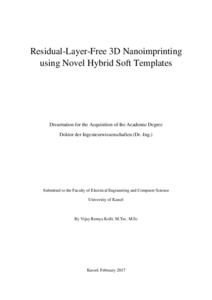| dcterms.abstract | Hybrid 3D soft templates are designed and evaluated for residual layer free 3D imprinting in UV-Substrate Conformal Imprint Lithography (SCIL). 3D imprinting usually results in laterally varying residual layers, which cannot be removed by conventional etching processes in a satisfactory manner. The hybrid templates introduced in this thesis are hybrid in a way that their template protrusions are enclosed with a UV-blocking metal layer, by this means selective UV curing of the resist material is attainable. Hence, the resist parts underneath the template protrusions remain uncured (Residual layer), and the resist in all other places becomes completely cured. Later on, the uncured residual layer areas are removed by the chemical development process. Thereby, a complete removal of the residual layer between the imprinted structures is attained in a single step, despite its non-uniformity. Also, this novel technique combines the advantages of conformal imprinting with Polydimethylsiloxane (PDMS) templates and selective UV-blocking advantages of conventional photomasks. As metallization of polymeric materials like PDMS is an extremely challenging task, various PDMS surface modifications techniques like oxygen plasma, and UV surface oxidation treatments are investigated and characterized. Owens & Wendt’s and goniometric measurement techniques are used to determine the contact angle and surface energies of the oxidized PDMS material. A combinational effect of oxygen and UV-oxidation decreased the contact of PDMS to 20° with a surface roughness < 1nm, making its surface perfectly suitable for metallization. Suitable metallization techniques over oxidized PDMS and structuring of the metals are experimentally evaluated. A combination of Titanium (5 nm) and Gold (80 nm), delivered a very good deposition quality and bonding to PDMS. Hence, the fabrication of hybrid templates with structured metal on its protrusion areas is successfully accomplished. Note that the conventional residual layer with UV-Nanoimprint varies between 10-80 nm. Within this work using the hybrid technique a residual layer of 0 nm thickness is attained. This residual layer free imprinting boosted the optical quality, throughput and surface roughness (< 2 nm) of the 3D SCIL process. Also, there is up to 90 % enhancement in maintaining the imprinted structure dimensions is achieved, thereby enhancing the aspect ratio. Standard PDMS templates are modified by depositing a monolayer of Ti over it. This modification decreased the contact angle between the resist and the template, thereby increasing the resist filling in the template cavities up to 80%. In addition to residual layer free imprinting, the hybrid templates are beneficially applied for the fabrication of Fabry-Pérot (FP) filter arrays. Micromachined optical FP filters with air-gap cavities enable a spectral tuning of the transmission wavelength. The air-gaps are created by etching the sacrificial layer in only desired locations. During the etching process, the filter supporting posts might also be etched along with air-gaps, resulting in undesired deformation in optical and mechanical properties of the filter array. The novel 3D hybrid templates are utilized and successfully implemented to imprint the sacrificial layer only at desired filter regions. With the principle of structuring the sacrificial layer, the under etching of the air-gaps for diverse filter sizes is effectively achieved in a solitary step. Henceforth, imprinting of the 3D filter cavities for FP filter arrays using the novel hybrid soft templates reveals a decent fabrication quality of the filter array and avoids a noticeable distortion of the filter supporting posts during the creation of air-gap cavities. | eng |

